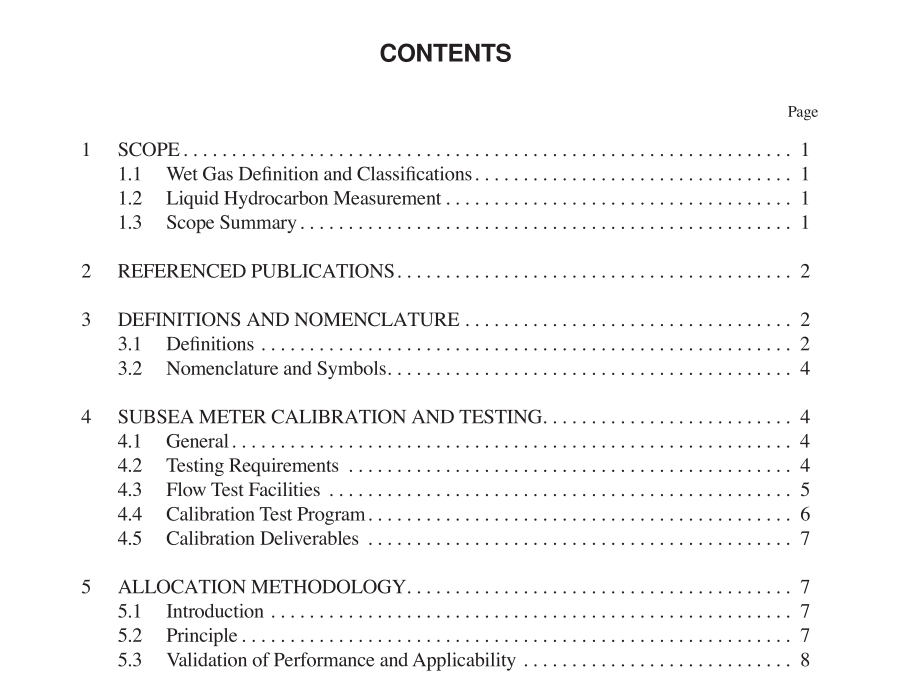API RP 85 pdf download

API RP 85 pdf download.Use of Subsea Wet-gas Flowmeters in Allocation Measurement Systems
1.2 LIQUID HYDROCARBON MEASUREMENT
A central problem that must be addressed for those using wet gas meters is the determination of the liquid hydrocarbon ßow rates of a well stream. A key issue is that water and hydrocarbon liquids co-exist in the liquid phase of the stream. Furthermore, the liquid measured by the wet gas meter may contain injected chemicals (hydrate inhibitor, corrosion inhib- itor, etc.), in addition to the condensate, oil, and/or water. In either case discussed below, the volume of injected chemicals ßowing through the wet gas meter must be known and input to the computations. Dependent on whether the wet gas that a particular well is expected to produce is Category 1 or Category 2, the effort to estimate liquid hydrocarbon ßow rates will range from very little to very much. The general procedure will be as follows: 1. Determine if there is an online method of measuring water volume fraction available that can be used in the application. 2. Obtain and analyze a sample of the reservoir ßuids for each well prior to the onset of normal production. Deter- mine the gas-oil ratio (GOR) of each. 3. For Category 1 Wet Gas, an average GOR may be utilized across all producing wells in the system. 4. Using the GOR derived from these samples and adjusted to each allocation meterÕs conditions, apply these factors to the gas production for each well to obtain the liquid hydrocarbon production for each. 5. For Category 2 Wet Gas, if the liquid hydrocarbon imbal- ance grows beyond a predetermined threshold, one of two avenues must be pursued: a. Actions must be taken to remedy the imbalance. This could involve acquiring a new sample from a well or all wells in the system, or re-estimating the GOR from sec- ondary data sources. Strategies for doing this are considered in Chapter 7 on Abnormal Operations, or b. A justiÞcation acceptable to all interested parties must be made to explain why choosing (a) is not appropriate. In the general case, a project will consist of a combination of Category 1 and Category 2 wells, therefore the plans for production must account for this.
3 Definitions and Nomenclature
3.1 DEFINITIONS 3.1.1 allocation: The (mathematical) process of assign- ing portions of a commingled production stream to the sources, typically wells, which contributed to the total ßow. 3.1.2 allocation meter: A ßow measurement device used for the speciÞc purpose of measuring the ßow rates from a single well or input ßowline; not to be confused with the ref- erence meter. 3.1.3 commingle: To combine the hydrocarbon streams from two or more wells or production facilities into common tanks or pipelines. 3.1.4 Equations of State (EOS): Equations which relate the compositions, pressures, temperatures, and various other physical properties of gases and liquids to one another, and are used to predict the transformation of physical state when conditions change (see PVT Analysis).3.1.5 error: The difference between the result of a mea- surement and the true value of the measurand. 3.1.6 estimate: A measurement which has been corrected to remove the effects of inßuence factors. 3.1.7 gas-oil ratio (GOR): The ratio of produced gas ßow rate to the liquid hydrocarbon ßow rate at any point, measured in standard cubic feet per barrel (SCF/BBL) or standard cubic meters of gas per cubic meter of liquid hydro- carbon (m 3 / m 3 ). 3.1.8 gas (liquid) volume fraction, GVF (LVF): The fraction of the total volumetric ßow at actual conditions in the pipe which is attributable to gas (liquid) ßow.









